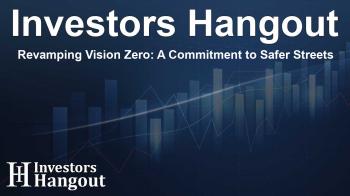Revamping Vision Zero: A Commitment to Safer Streets

San Francisco's Vision Zero Faces Critical Overhaul
The San Francisco Civil Grand Jury's recent report uncovers significant challenges facing the city's Vision Zero initiative, a program designed to eliminate traffic fatalities. Despite being adopted in 2014 with ambitious goals, the city reported alarming statistics indicating that 2024 has become the deadliest year for traffic safety since 2007.
Failures in Implementation
The report titled "Failed Vision: Revamping the Roadmap to Safer Streets" outlines disturbing failures in traffic law enforcement that have jeopardized the safety of all roadway users. The San Francisco Municipal Transportation Agency (SFMTA) has indeed worked to bolster street safety, particularly for pedestrians and cyclists over the years. However, the San Francisco Police Department's (SFPD) nearly complete withdrawal from traffic law enforcement has posed considerable risks, resulting in a staggering decline in traffic citations, which reached an almost negligible level in recent years.
Call for Renewed Commitment
The Grand Jury emphasizes the urgent need for the SFPD to recommit to strict traffic law enforcement. Furthermore, they recommend that the SFMTA improve its implementation pace through strategic planning and by fostering community trust. An increase in public education efforts aimed at high-risk road users is essential to create a collective sense of responsibility for safer streets. Katherine Blumberg, Chair of the Investigation Committee, stated, "At the end of the Vision Zero decade, San Francisco needs to redouble its efforts to make meaningful progress on street safety.
Addressing Citywide Safety Concerns
Foreperson Michael Carboy highlighted the alarming atmosphere of lawlessness currently evident on city streets due to minimal enforcement measures. He noted the increasing dangers posed by reckless driving and excessive speeding that endanger pedestrians, cyclists, and motorists alike, declaring that the report highlights the urgent need for action.
Recommendations for Safer Roadways
To create tangible improvements toward achieving Vision Zero goals, the Jury laid out several key recommendations for the city, focused on enhancing both education and enforcement:
- Formulate a comprehensive enforcement strategy that establishes clear enforcement objectives and accountability while integrating advanced technology to enhance efficiency.
- Engage in proactive, community-oriented engineering interventions to address dangerous conditions proactively before any tragedies occur.
- Initiate ongoing public education campaigns that cultivate a citywide commitment towards safer streets for everyone.
Looking Ahead with New Leadership
As San Francisco stands at a pivotal moment with new leadership, including a mayor, a director of transportation, and soon, a new police chief, Blumberg urged the city not to give up on the Vision Zero initiative. Instead, she asserted that now is the moment to learn from past mistakes and truly commit to fostering safer streets.
About the Civil Grand Jury
The Civil Grand Jury, comprising 19 selected members from the local community, is vested with the power to investigate government entities by reviewing documents and interviewing officials. Upon completion of their inquiries, the Jury publishes reports detailing their findings and recommending actionable changes. Agencies mentioned in these reports are required to respond within a specified timeframe, promoting accountability through public hearings. The goal is to enhance governance and community safety.
Frequently Asked Questions
What is the Vision Zero initiative in San Francisco?
Vision Zero is a traffic safety initiative aimed at eliminating traffic deaths in San Francisco, adopted in 2014.
What are the main issues identified in the Grand Jury report?
The report highlights lapses in traffic law enforcement and the need for renewed commitment to safety measures from the SFPD and SFMTA.
What recommendations were made for improving traffic safety?
Suggestions include developing a detailed enforcement strategy, implementing community-driven interventions, and launching public education campaigns.
Why is community engagement important in this context?
Community engagement fosters trust and collective responsibility, which are critical in achieving meaningful progress toward safer streets.
What is the role of the Civil Grand Jury?
The Civil Grand Jury investigates government actions, producing reports to recommend improvements and ensure accountability among public agencies.
About The Author
Contact Henry Turner privately here. Or send an email with ATTN: Henry Turner as the subject to contact@investorshangout.com.
About Investors Hangout
Investors Hangout is a leading online stock forum for financial discussion and learning, offering a wide range of free tools and resources. It draws in traders of all levels, who exchange market knowledge, investigate trading tactics, and keep an eye on industry developments in real time. Featuring financial articles, stock message boards, quotes, charts, company profiles, and live news updates. Through cooperative learning and a wealth of informational resources, it helps users from novices creating their first portfolios to experts honing their techniques. Join Investors Hangout today: https://investorshangout.com/
The content of this article is based on factual, publicly available information and does not represent legal, financial, or investment advice. Investors Hangout does not offer financial advice, and the author is not a licensed financial advisor. Consult a qualified advisor before making any financial or investment decisions based on this article. This article should not be considered advice to purchase, sell, or hold any securities or other investments. If any of the material provided here is inaccurate, please contact us for corrections.

